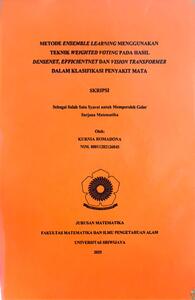ROMADONA, KURNIA and Desiani, Anita and Andriani, Yuli (2025) METODE ENSEMBLE LEARNING MENGGUNAKAN TEKNIK WEIGHTED VOTING PADA HASIL DENSENET, EFFICIENTNET DAN VISION TRANSFORMER DALAM KLASIFIKASI PENYAKIT MATA. Undergraduate thesis, Sriwijaya University.
![[thumbnail of RAMA_44201_08011282126045.jpeg]](http://repository.unsri.ac.id/169747/1.hassmallThumbnailVersion/RAMA_44201_08011282126045.jpeg)  Preview |
Image
RAMA_44201_08011282126045.jpeg - Cover Image Available under License Creative Commons Public Domain Dedication. Download (378kB) | Preview |
|
Text
RAMA_44201_08011282126045.pdf - Accepted Version Restricted to Repository staff only Available under License Creative Commons Public Domain Dedication. Download (29MB) | Request a copy |
|
|
Text
RAMA_44201_08011282126045_TURNITIN.pdf - Accepted Version Restricted to Repository staff only Available under License Creative Commons Public Domain Dedication. Download (28MB) | Request a copy |
|
|
Text
RAMA_44201_08011282126045_0011127702_0002077202_01_front_ref.pdf - Accepted Version Available under License Creative Commons Public Domain Dedication. Download (6MB) |
|
|
Text
RAMA_44201_08011282126045_0011127702_0002077202_02.pdf - Accepted Version Restricted to Repository staff only Available under License Creative Commons Public Domain Dedication. Download (6MB) | Request a copy |
|
|
Text
RAMA_44201_08011282126045_0011127702_0002077202_03.pdf - Accepted Version Restricted to Repository staff only Available under License Creative Commons Public Domain Dedication. Download (1MB) | Request a copy |
|
|
Text
RAMA_44201_08011282126045_0011127702_0002077202_04.pdf - Accepted Version Restricted to Repository staff only Available under License Creative Commons Public Domain Dedication. Download (14MB) | Request a copy |
|
|
Text
RAMA_44201_08011282126045_0011127702_0002077202_05.pdf - Accepted Version Restricted to Repository staff only Available under License Creative Commons Public Domain Dedication. Download (268kB) | Request a copy |
|
|
Text
RAMA_44201_08011282126045_0011127702_0002077202_06_ref.pdf - Bibliography Restricted to Repository staff only Available under License Creative Commons Public Domain Dedication. Download (1MB) | Request a copy |
Abstract
Eye diseases are conditions that affect visual function and eye health. Eye diseases can be grouped into cataracts, Diabetic Retinopathy (DR) and glaucoma. Early detection can be done by utilizing Deep Learning. Deep Learning architectures that can be used include DenseNet, EfficientNet and ViT. DenseNet can connect information between layers with the dense block and transition layer process, where each layer receives input from all previous layers and sends output to all subsequent layers. The density of connection relationships in DenseNet leads to many iterations of information processing, thus increasing memory requirements. EfficientNet uses compound scaling, to proportionally optimize the depth, width and resolution of the model. Unlike DenseNet, EfficientNet relies on MBConv which consists of depthwise convolution and SE to reduce the number of unnecessary convolution operations and reduce memory usage. In general, CNN architectures have difficulty in understanding global relationships because they use convolution processes. The architecture that has the ability to capture global relationships is ViT because it uses a self-attention process, but ViT tends to have difficulty in classifying minority classes. The average evaluation result of each single architecture on accuracy is 96%, which means it can predict most eye diseases correctly. Sensitivity is 95%, which means the model is sensitive to the normal class. Specificity was 97%, which means the accuracy in predicting the eye disease class. F1-Score of 95% indicates a good balance of precision and sensitivity and Cohen's Kappa of 0.87 shows the consistency of predictions with the actual label, but the results of the accuracy and loss training graphs are still experiencing ovefitting. The application of Ensemble Learning using weighted voting technique with FC learning produces accuracy and loss training graphs that are not overfitting. Ensemble Learning provides an improvement on a single classification with an accuracy value of 2%, sensitivity of 4%, specificity of 2%, F1-Score of 4%, and Cohen's Kappa of 11%. The evaluation results are very good for each class, but still quite low in the glaucoma class, which is still below 95%. Future research is expected to improve the classification of the glaucoma class.
| Item Type: | Thesis (Undergraduate) |
|---|---|
| Uncontrolled Keywords: | DenseNet, EfficientNet, Fully Connected, Vision Transformer, Weighted VotinG |
| Subjects: | Q Science > QA Mathematics > QA8.9-QA10.3 Computer science. Artificial intelligence. Computational complexity. Data structures (Computer scienc. Mathematical Logic and Formal Languages |
| Divisions: | 08-Faculty of Mathematics and Natural Science > 44201-Mathematics (S1) |
| Depositing User: | Kurnia Romadona |
| Date Deposited: | 21 Mar 2025 07:02 |
| Last Modified: | 21 Mar 2025 07:02 |
| URI: | http://repository.unsri.ac.id/id/eprint/169747 |
Actions (login required)
 |
View Item |
